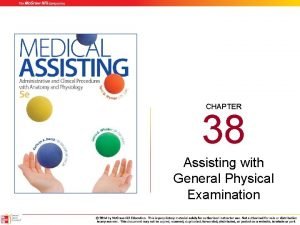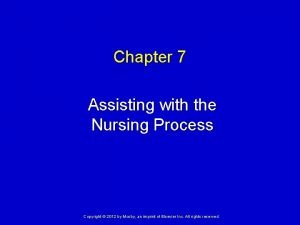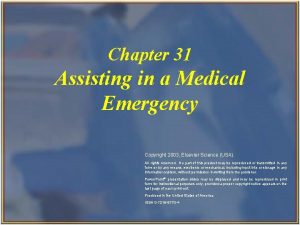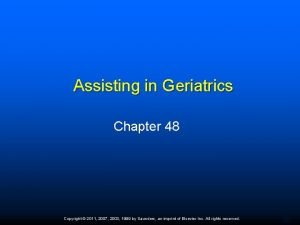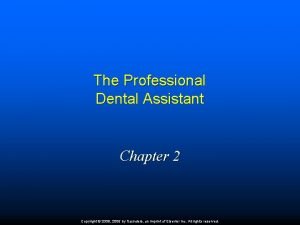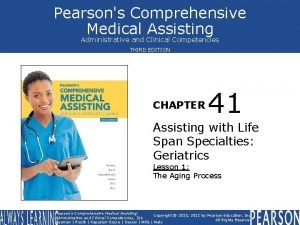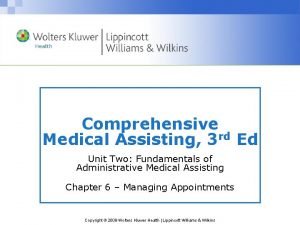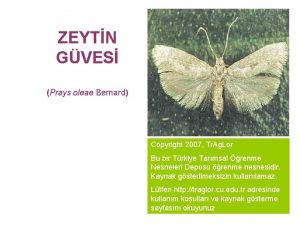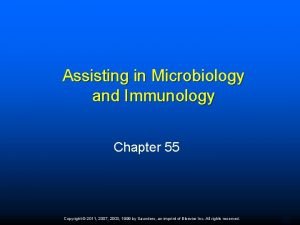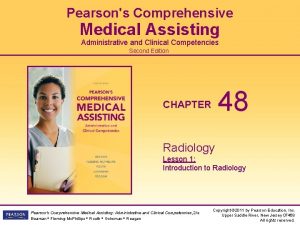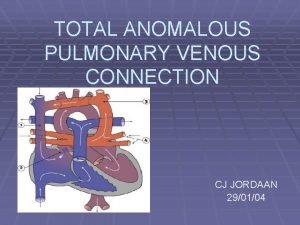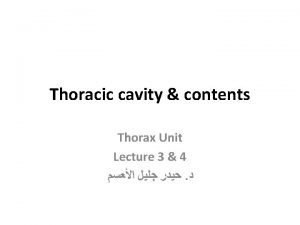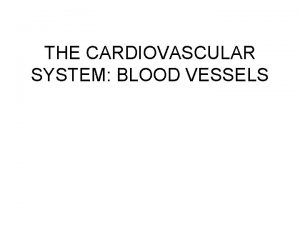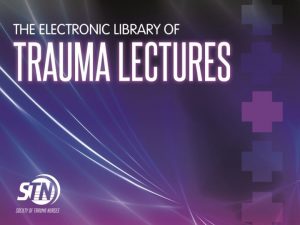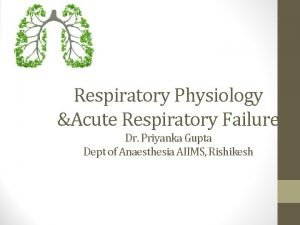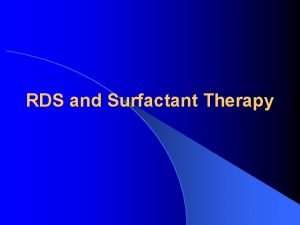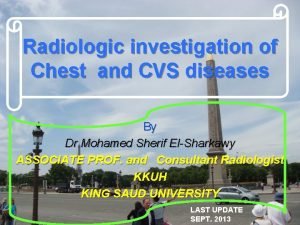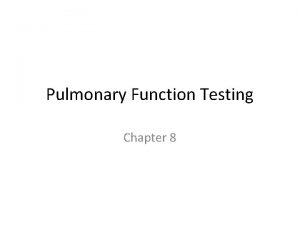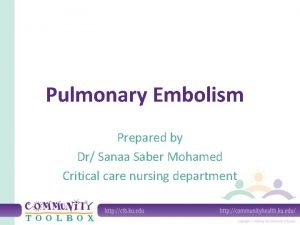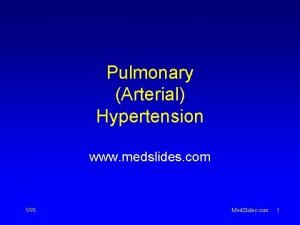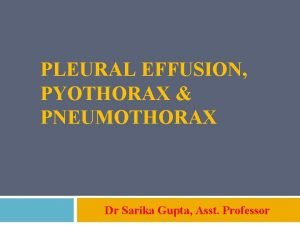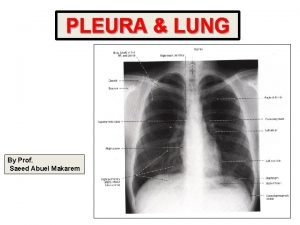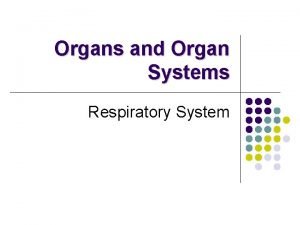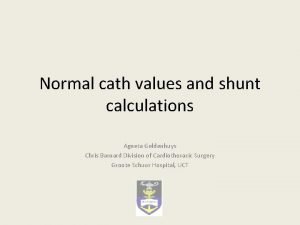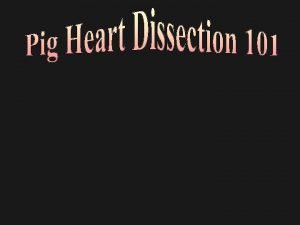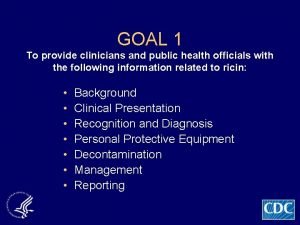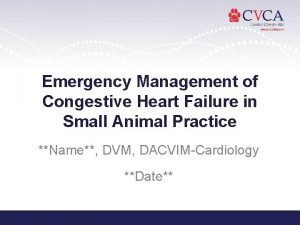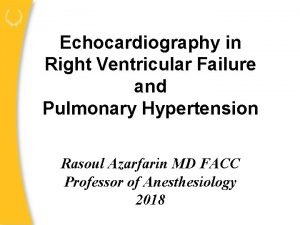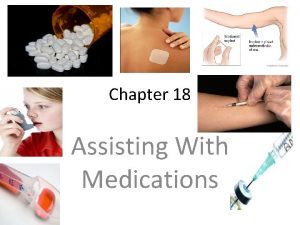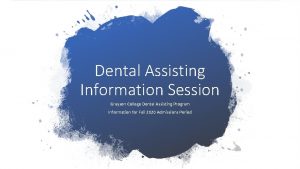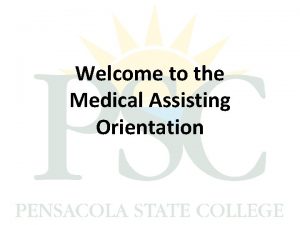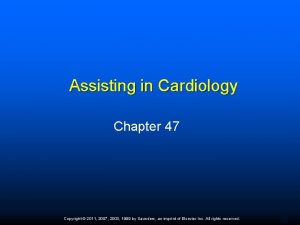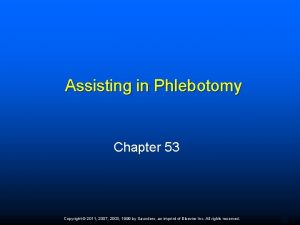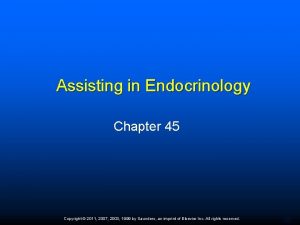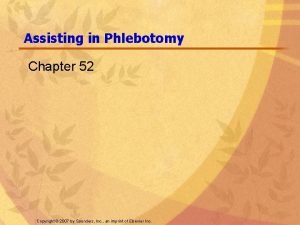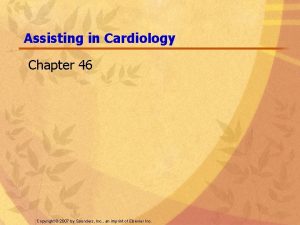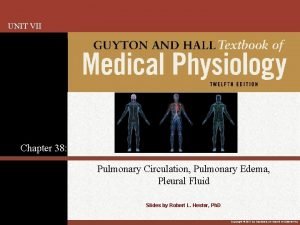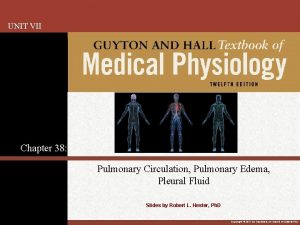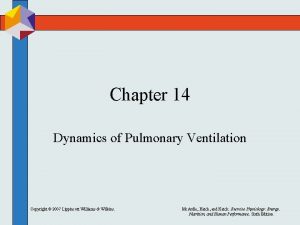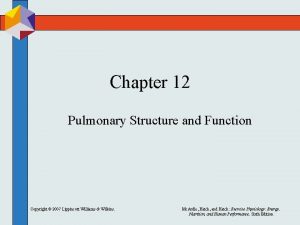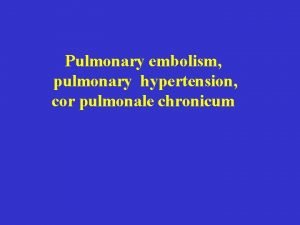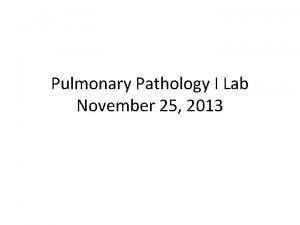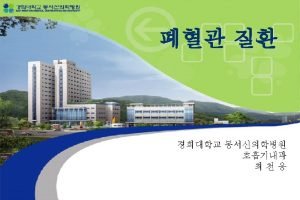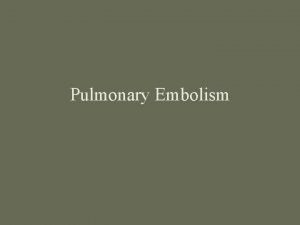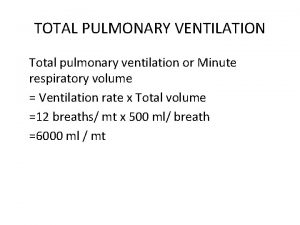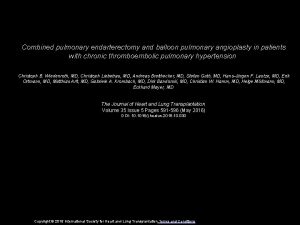Assisting in Pulmonary Medicine Chapter 45 Copyright 2007





































- Slides: 37

Assisting in Pulmonary Medicine Chapter 45 Copyright © 2007 by Saunders, Inc. , an imprint of Elsevier Inc.

Respiratory System n The respiratory system – Exchanges oxygen from the atmosphere for carbon dioxide waste l External l Internal – Maintains acid-base balance – Ventilation process controlled by respiratory center in the CNS and assisted by the costal and diaphragm muscles Copyright © 2007 by Saunders, Inc. , an imprint of Elsevier Inc. 2

Upper and Lower Respiratory Tracts n n Upper—nose, pharynx, larynx; air filtered by cilia in nose, warmed by capillaries, and moistened by mucous membrane; epiglottis protects opening into larynx; vocal cords vibrate when air is exhaled to create sound Lower—trachea, bronchial tubes, lungs, bronchioles, and alveoli; lined with mucous tissue and cilia to filter and moisten air Copyright © 2007 by Saunders, Inc. , an imprint of Elsevier Inc. 3

Lungs n n n Right—three lobes; greater volume capacity than left lung Left—two lobes; longer and narrower Each lung encased in the double-layered pleural membrane – visceral and parietal layers – pleural fluid Copyright © 2007 by Saunders, Inc. , an imprint of Elsevier Inc. 4

Lungs Copyright © 2007 by Saunders, Inc. , an imprint of Elsevier Inc. 5

Respiration and Circulation n The respiratory and circulatory systems work together to supply body cells with oxygen and remove metabolic wastes. The bronchioles deposit oxygenated air into the alveoli. Surrounding each alveolus is a network of pulmonary capillaries filled with waste air. The oxygenated air moves through the single-celled walls of the alveoli and through the single-celled walls of these capillaries. Carbon dioxide is forced out of the capillaries, into the alveoli, and then into the bronchioles. Copyright © 2007 by Saunders, Inc. , an imprint of Elsevier Inc. 6

Ventilation n This exchange of gas is referred to as ventilation. The movement of oxygen from the atmosphere into the alveoli is called inspiration. The movement of the waste gases from the alveoli back into the atmosphere is called expiration. Copyright © 2007 by Saunders, Inc. , an imprint of Elsevier Inc. 7

Bronchioles and Alveoli Copyright © 2007 by Saunders, Inc. , an imprint of Elsevier Inc. 8

Respiratory System Defenses n Upper respiratory tract – Mucus-covered ciliated surfaces n Lower respiratory tract – Sterile – Ever-changing air flow – Functions of the immune system Copyright © 2007 by Saunders, Inc. , an imprint of Elsevier Inc. 9

Major Diseases of the Respiratory System n Common symptoms include sneezing, productive or nonproductive cough, sore throat, hoarseness, fever, general malaise, altered breath sounds, and changes in breathing patterns. Copyright © 2007 by Saunders, Inc. , an imprint of Elsevier Inc. 10

Infectious Disease: Upper Respiratory Tract n Upper respiratory tract infections include: – Common cold—caused by virus and has no cure – Sinusitis—causes edema and collection of mucus within sinus cavity, creating a feeling of pressure, either nasal congestion or rhinorrhea, and classic sinus headaches l Treatment: decongestant, antibiotic, analgesic – Allergic rhinitis—reaction of nasal mucosa to an environmental allergen l Treatment: antihistamines (OTC or Allegra, Zyrtec), nasal sprays Copyright © 2007 by Saunders, Inc. , an imprint of Elsevier Inc. 11

Infectious Disease: Lower Respiratory Tract n Lower respiratory tract infections include pneumonia— inflammation of all or part of the lungs that is caused by bacteria, viruses, irritants, or other pathogens – Symptoms—fever, chills, general malaise, cough, hemoptysis, rales, rhonchi, possible empyema – Diagnosis—chest x-ray films, elevated WBC if bacterial – Treatment—antibiotics if bacterial, palliative if viral Copyright © 2007 by Saunders, Inc. , an imprint of Elsevier Inc. 12

Types of Pneumonia Copyright © 2007 by Saunders, Inc. , an imprint of Elsevier Inc. 13

Tuberculosis n n n Serious increase since 1980 s Caused by Mycobacterium tuberculosis bacteria; develops spores; transmitted via sputum droplets that are inhaled into susceptible host Primary TB—healthy individual isolates infection into a tubercle and doesn’t develop disease, or unhealthy person inhales bacillus and develops disease Secondary TB—bacilli in tubercles becomes active because of decreased host resistance Signs and symptoms—productive cough with thick, blood-tinged mucus Copyright © 2007 by Saunders, Inc. , an imprint of Elsevier Inc. 14

TB Diagnosis and Treatment n n Diagnosis: positive PPD screening followed by positive chest x-ray film and sputum culture. Positive PPD does not necessarily indicate active TB— simply means individual was exposed. Treatment: long-term combination drug therapy; isoniazid (INH) daily for 6 to 12 months if PPD positive but sputum culture negative; four-drug regimen daily for 6 months for active TB; treatment continues for 3 months beyond negative culture. All healthcare workers should have annual PPD or chest x-ray film if history of positive PPD. Copyright © 2007 by Saunders, Inc. , an imprint of Elsevier Inc. 15

Chronic Obstructive Pulmonary Disease n n n Chronic obstructive pulmonary disease (COPD) is a group of diseases with chronic airway obstruction. Among these diseases are chronic bronchitis, bronchiectasis, asthma, pneumoconiosis, and emphysema. The patient with COPD is unable to ventilate the lungs freely, resulting in an ineffective exchange of respiratory gases. Treatments include bronchodilator and corticosteroid inhalers, evaluation of peak flow values, and nebulizer treatments. Copyright © 2007 by Saunders, Inc. , an imprint of Elsevier Inc. 16

Asthma n Triggers cause inflammation and bronchospasm. n May be exercise-induced or a chronic problem. n n n Signs and symptoms—nonproductive cough, dyspnea, expiratory wheezing, chest tightness, rhonchi; may also have tachycardia, pallor, diaphoresis. Inflammation causes edema and mucous secretion in the bronchioles, and bronchospasms cause air to be trapped in lungs. Spirometry reveals airflow obstruction. Copyright © 2007 by Saunders, Inc. , an imprint of Elsevier Inc. 17

Asthmatic Bronchioles n n During an asthma attack, smooth muscles located in the bronchioles of the lung constrict and decrease the flow of air in the airways. The amount of air flow is further decreased by inflammation or excess mucous secretion. Copyright © 2007 by Saunders, Inc. , an imprint of Elsevier Inc. 18

Exercise-Induced Asthma n n Exercise-induced asthma is distinct from allergic asthma in that it does not produce a long-term increase in airway activity. People who experience asthma only when they exercise may be able to control their symptoms with preventive measures such as warm-up and cool-down exercises or using a bronchodilator before exercise. Copyright © 2007 by Saunders, Inc. , an imprint of Elsevier Inc. 19

Management of Asthma n Peak flow measurements either daily or at onset of attack to assess ability to move air into and out of lungs. – Measures the peak expiratory flow rate—fastest speed at which patient can blow air out of lungs after taking in big breath. – Patient should take three readings, blowing out as hard as possible, and the highest value should be recorded. RX: bronchodilator rescue inhalers (Ventolin, Atrovent, Max. Air); steroid inhalers for inflammation (Aerobid, Azmacort, Flovent) or oral Accolate or Singulair. Copyright © 2007 by Saunders, Inc. , an imprint of Elsevier Inc. 20

Peak Flow Meter Copyright © 2007 by Saunders, Inc. , an imprint of Elsevier Inc. 21

Asthma Triggers n n n Common allergens, including pollen, dust mites, mold, and pet dander. Irritants such as smoke, pollution, fumes, cleaning chemicals, and sprays. Asthma symptoms can be substantially reduced by avoiding exposure to known allergens and respiratory irritants. Copyright © 2007 by Saunders, Inc. , an imprint of Elsevier Inc. 22

Pneumoconioses n Environmental causes of respiratory disease: – Anthracosis – Asbestosis – Silicosis Copyright © 2007 by Saunders, Inc. , an imprint of Elsevier Inc. 23

Emphysema n n n Destruction of alveoli because of overinflation and difficulty with expiration Progressive and irreversible Causes—cigarette smoking, occasionally genetic predisposition, pollutants, chronic bronchitis or asthma Signs and symptoms—dyspnea, SOB, wheezing, thick mucus, fatigue, anorexia, persistent cough, peripheral cyanosis, clubbing of fingers DX—PFT shows increased residual volume and decreased forced expiratory volume RX—oxygen therapy, nebulizer treatments, bronchodilators, high-calorie diet, pursed-lip breathing Copyright © 2007 by Saunders, Inc. , an imprint of Elsevier Inc. 24

Emphysema and Cigarette Smoking n n Cigarettes contain many hazardous substances that damage the lungs when inhaled, including tar, nicotine, carbon monoxide, and cyanide. Long-term exposure to secondhand tobacco smoke and/or repeated respiratory infections also can increase a person's risk for chronic obstructive pulmonary disorder. Copyright © 2007 by Saunders, Inc. , an imprint of Elsevier Inc. 25

Obstructive Sleep Apnea (OSA) n n n Muscles in the posterior pharynx relax during sleep. Trachea narrows or closes with inhalation, momentarily stopping breathing. Treatment: CPAP, dental devices, surgery. Copyright © 2007 by Saunders, Inc. , an imprint of Elsevier Inc. 26

OSA n Signs and symptoms – Excessive daytime sleepiness – Persistent loud, disruptive snoring – Snoring, choking, or gasping sounds during sleep – Episodes of breathing cessation during sleep – Awakening with a dry mouth or sore throat – Morning headache Copyright © 2007 by Saunders, Inc. , an imprint of Elsevier Inc. 27

Pulmonary System Tumors: Lung Cancer n n The most prevalent neoplasms of the respiratory system are lung cancer and carcinoma of the larynx. Lung cancer is the leading cause of cancer-related deaths for both men and women and is a common site for secondary tumors from metastasis as well as primary carcinomas. Copyright © 2007 by Saunders, Inc. , an imprint of Elsevier Inc. 28

Pulmonary System Tumors: Lung Cancer (cont’d) Copyright © 2007 by Saunders, Inc. , an imprint of Elsevier Inc. 29

Cancer Prognosis n n n Prognosis is very poor for lung cancer because early symptoms mimic chronic conditions in long-term smokers. Carcinoma of the larynx is linked to smoking and chronic alcohol consumption. Most laryngeal tumors are discovered in their early stages and carry a very good prognosis. Copyright © 2007 by Saunders, Inc. , an imprint of Elsevier Inc. 30

The Medical Assistant’s Role in Pulmonary Procedures n Assisting with the examination – Have patient disrobe to the waist and don a gown with the opening in front n The medical assistant is responsible for assisting the physician throughout the examination, providing the patient privacy and support, and performing diagnostic tests as ordered. Copyright © 2007 by Saunders, Inc. , an imprint of Elsevier Inc. 31

Diagnostic Tests n Respiratory system diagnostic procedures – Pulmonary function tests—performed with a spirometer; used to diagnose a pulmonary abnormality and/or determine the extent of a pulmonary disease – Pulse oximetry—a noninvasive method of evaluating the oxygen saturation of hemoglobin in arterial blood and the pulse rate – Cultures—performed on expectorated sputum to identify infectious pathogens – Bronchoscopy—viewing the larynx, trachea, and bronchi with a flexible fiberoptic instrument through which the physician collect biopsies or bronchial washings for cytology or culture Copyright © 2007 by Saunders, Inc. , an imprint of Elsevier Inc. 32

Spirometry n n Spirometry is a painless study of air volume and flow rate within the lungs. Frequently used to evaluate lung function in people with obstructive or restrictive lung diseases such as asthma or cystic fibrosis. Copyright © 2007 by Saunders, Inc. , an imprint of Elsevier Inc. 33

Hand-held pulse oximeter Copyright © 2007 by Saunders, Inc. , an imprint of Elsevier Inc. 34

Bronchoscopy n n Technique for viewing the interior of the airways using sophisticated flexible fiberoptic instruments; physician explores the trachea, main stem bronchi, and some of the small bronchi. In children this procedure may be used to remove foreign objects that have been inhaled. In adults the procedure is most often used to take samples of suspicious lesions (biopsy) and for culturing specific areas in the lung. Copyright © 2007 by Saunders, Inc. , an imprint of Elsevier Inc. 35

Bronchoscope n n n Fiberoptic tube with a tiny camera on the end is inserted through the nose (or mouth) into the lungs. During a bronchoscopic procedure, the scope passes through the throat into the trachea and bronchi to provide a view of the tracheobronchial tree. The scope also allows the doctor to collect lung secretions and lung tissue specimens for biopsy. Copyright © 2007 by Saunders, Inc. , an imprint of Elsevier Inc. 36

Patient Education n The medical assistant can play a vital role in allaying patient fears by explaining diagnostic tests, making certain the patient understands how to prepare for the examination and what will be expected of him or her during the procedure. n Provide literature. n Answer questions. Copyright © 2007 by Saunders, Inc. , an imprint of Elsevier Inc. 37
 Chapter 42 assisting in other medical specialties
Chapter 42 assisting in other medical specialties Chapter 38 assisting with a general physical examination
Chapter 38 assisting with a general physical examination Chapter 6 dental assisting
Chapter 6 dental assisting Chapter 5 assisting with the nursing process
Chapter 5 assisting with the nursing process Chapter 31 assisting in a medical emergency
Chapter 31 assisting in a medical emergency Chapter 41 assisting in geriatrics
Chapter 41 assisting in geriatrics Chapter 2 the professional dental assistant
Chapter 2 the professional dental assistant Chapter 41 assisting in geriatrics
Chapter 41 assisting in geriatrics Chapter 42 assisting in other medical specialties
Chapter 42 assisting in other medical specialties Copyright 2007
Copyright 2007 Copyright 2007
Copyright 2007 Medical assistant program rop
Medical assistant program rop Guest departure meaning
Guest departure meaning Advertise verb
Advertise verb Assisting in microbiology and immunology
Assisting in microbiology and immunology Pearson comprehensive medical assisting
Pearson comprehensive medical assisting Tapvd
Tapvd Sibsons fascia
Sibsons fascia Pearson mastering
Pearson mastering Pulmonary toilet
Pulmonary toilet The pulmonary semilunar valve
The pulmonary semilunar valve Pulmonary toilet
Pulmonary toilet Pulmonary surfactant function
Pulmonary surfactant function Cvs x ray
Cvs x ray Fef 200-1200
Fef 200-1200 Westermark sign
Westermark sign Pulmonary embolism diagnosis
Pulmonary embolism diagnosis Med
Med Complications of empyema
Complications of empyema Fibroserous
Fibroserous Trachea lining
Trachea lining Normal pvr woods units
Normal pvr woods units Management of hemorrhage
Management of hemorrhage Pulmonary edema
Pulmonary edema Papillary muscles sheep heart
Papillary muscles sheep heart Cardiorespiratory failure
Cardiorespiratory failure Cardiac vs pulmonary dyspnea
Cardiac vs pulmonary dyspnea Calculate rvsp on echo
Calculate rvsp on echo

